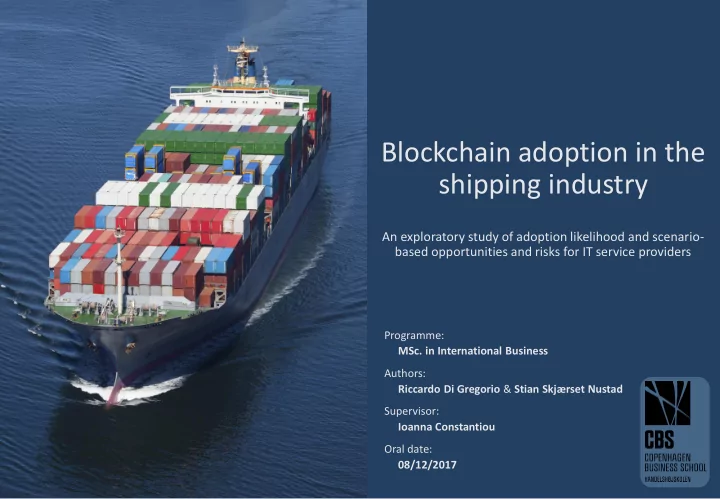

Blockchain adoption in the shipping industry An exploratory study of adoption likelihood and scenario- based opportunities and risks for IT service providers Programme: MSc. in International Business Authors: Riccardo Di Gregorio & Stian Skjærset Nustad Supervisor: Ioanna Constantiou Oral date: 08/12/2017
Agenda • Reflect on research scope and methodology • Provide a visualization to clarify the answering process • Consider the implications of our study • Reflect on future research
Why blockchain in the shipping industry?
The merchant shipping and port segments • Reasons for focusing on these segments • Most influential for maritime commerce • Merchant shipping accounts for 1/3 of total maritime business turnover • Ports are fundamental hubs for commercial operations • Blockchain applications are being tailored for these two segments
Reflecting on the TASC model • How did the model tailor to our study? • Blockchain initiatives – use in a B2B context • Most adoption theories – individual adoption and fail to account for greater complexity (E.g. the TAM and AIM models) • TASC model – only comprehensive inter-firm adoption model • However … it considers all inter-firm technologies • Blockchain is unique – enables trust • This conflicts with the trust proposition
Reflecting on scenario planning • How did the tool tailor to our study? • Multidimensional approach to decision- making • Often applied by MNCs – relevant for the shipping industry • Schwenker & Wulf methodology – structured approach • However … it isn’t perfect Ranking Description • Even if valid – ranking scale is broad 1 Very low (impact or predictability) 2 Low (impact or predictability) • Day, Schoemaker, & Gunther (2000) may 3 Moderate (impact or predictability) 4 High (impact or predictability) have a better ranking approach 5 Very high (impact or predictability)
Answering Research Question 1 • RQ1: How likely is for blockchain technology to be adopted by shipping industry actors? • Underlying principle of the TASC model: The higher the intention to use an inter-firm technology, the more likely for it to be used and adopted
Answering Research Question 1 (cont.) • The factor of relative advantage we had the following proposition: The perceived relative advantage of the technology being adopted is positively associated with the intention to adopt B2B technologies. • Respondents identified two main advantages of blockchain: i. it connects the currently dispersed and fragmented IT system landscape to overcome data silos. ii. it enforces the accountability among actors along the maritime logistic chain. • Based on these findings we determined that blockchain was perceived to have advantages compared to existing technologies the relative advantage factor increases adoption likelihood or makes adoption more likely
Answering Research Question 2
Academic implications • Connection between TASC model and scenario planning • Achieved deeper insights compared to their separate use • PESTLE analysis is an extension of the external environment • External environment provided further insights into scenarios (e.g. industry support) • Improved scenario planning methodology • Changes to Step 2 of Schwenker & Wulf (2013) methodology • Improved quality of data collection by: • Overcoming shortcomings of 1 st questionnaire • Revealing additional reasoning , opinions and experiences during the ranking process
Managerial implications • Monitoring tool for adoption likelihood • This thesis: • showed how to assess blockchain adoption • identified obstacles which might improve currently uncertain adoption • Managers can use the TASC model as tool to monitor future factor developments • Decision-aiding tool for strategy development • Scenarios built on most uncertain and impactful adoption factors • Managers should anticipate the future direction of the industry … developing optimal strategies
Future research • Narrower approach for dominant applications • Architectural design may differ greatly between applications • E.g. consensus protocol • More delineated use cases conduct a focused study on blockchain adoption assessing uncertain TASC factors such as cost and compatibility • Examining the role of trust • The lack of trust could incentivize blockchain adoption in the industry. • However … an industry-wide adoption would need a significant degree of collaboration.
Recommend
More recommend